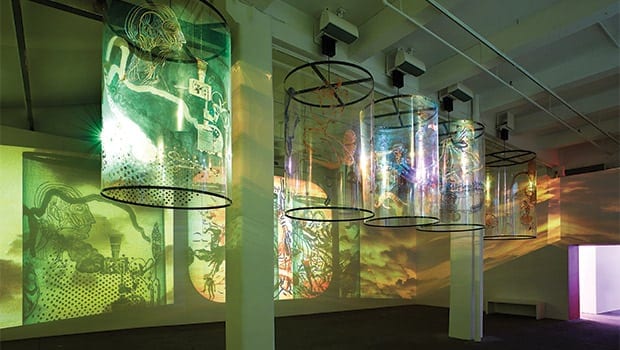‘In Search of Vanished Blood’
Artist Nalini Malani confronts her war-torn past in mixed-media exhibit at ICA through Oct. 16

World-renowned media artist Nalini Malani never got a childhood. At just a few years old she was ripped from her home in Karachi, now Pakistan, and forced into the difficult life of a refugee, without ever knowing the home she left behind. Her exhibit “In Search of Vanished Blood,” showing at the ICA through October 16, reflects her experience of female suffering during the Partition of India, which divided the British Indian Empire into Pakistan and India.

Author: Photo: Courtesy ICAArtist Nalini Malani’s installations at the Institute for Contemporary Art.
The exhibit opens up with two walls of mixed-media collages. In each piece there is a background photograph of a female face. In some cases the face is completely covered by fabric with a world map printed on it. In other cases, minimal covering allows us to see the pained, wild eyes of the woman behind the headdress. In one, more explicit piece, one man holds another at gunpoint while a woman watches from the sidelines. A plane explodes in the background.
Despite its name, the Partition of India was not a comfortable experience, and neither is Malani’s work. Between 200,000 and two million people were killed in retributive religious genocides during the transition, and another 14 million Hindus, Sikhs and Muslims were displaced. Malani’s work is a stark, violent depiction of the female experience during the largest mass migration in human history.
In another media piece, two women stand beside the drawn outline of a brain. They use long sticks to poke at two bulbous cell-shaped organisms floating in the brain. Perhaps they are attempting to recover some of their stifled personalities, lost within themselves. In many of the works, the drawn and cutout women are expressionless despite the violence around them. They have become immune to the destruction. Standing there, absent-mindedly watching executions and explosions, they beg the question, “In a world like this, is it better to live or to die?”
The centerpiece of the exhibit is a large room featuring an immersive media installation. All four walls feature projection, while five cylinders covered in mythological drawings hang from the ceiling and spin. Malani was one of the first artists of her kind to incorporate video into her work. Caged as she was in her cultural position, she searched desperately for freedom in her art. In this video piece, women’s faces flash across the walls, covered by another projection layer of blood. A voice says, “I reject all the sperm I have received. I take back the world I gave birth to.” The fantastical creatures painted on the spinning cylinders reflect onto the walls at varying times. The result is entrancing visual storytelling, making a tragic narrative beautiful.
Malani’s work references a very specific experience. Her images of Indian culture clash explode on the temperate Boston art scene like the bombs in her film stills. “In Search of Vanished Blood” is informative, estranged and deeply personal. After a 50-year career, Malani is well-versed in reaching an audience who may not have been through what she has. Her media is aesthetically intricate and,= most of all, touches the lonely, frightened bit of humanity in all of us that longs for a home.


![Banner [Virtual] Art Gallery](https://baystatebanner.com/wp-content/uploads/2024/04/Cagen-Luse_Men-at-store-e1713991226112-150x150.jpg)



